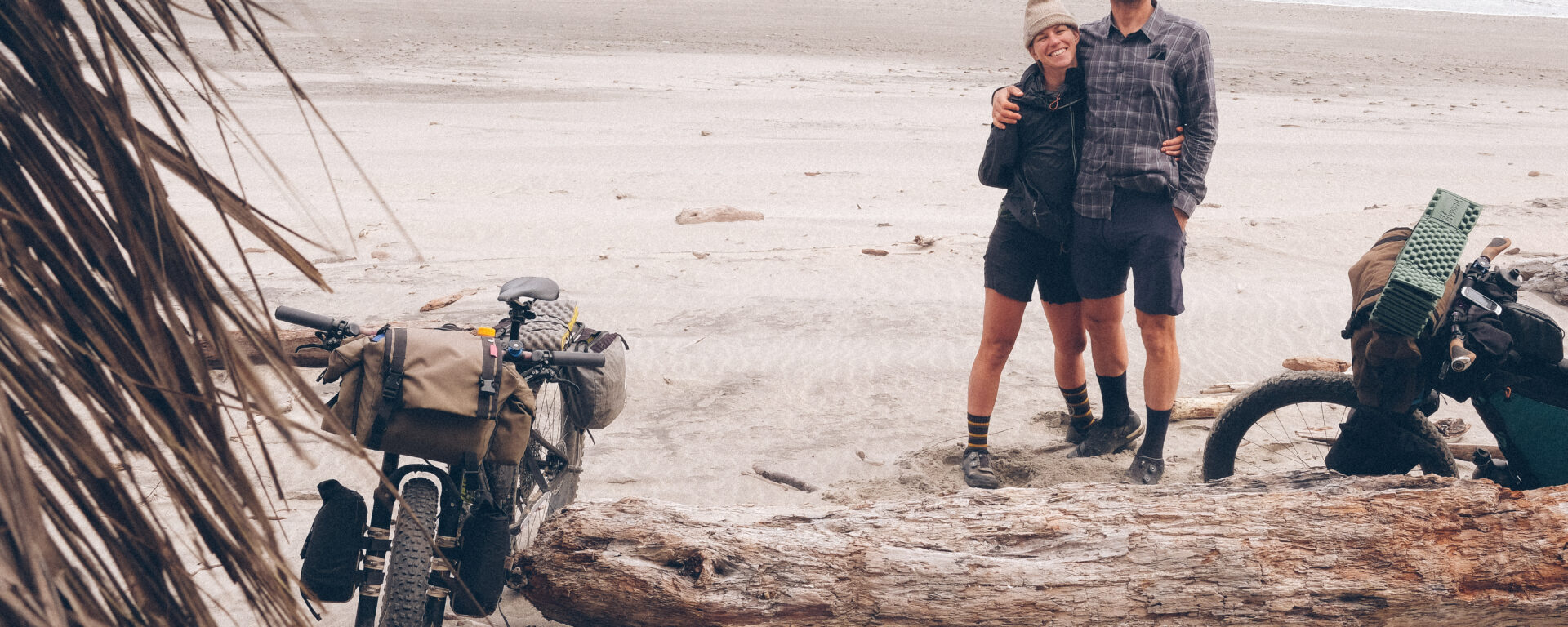Words and photos by Sarah Swallow
Having fun together is vital to relationship satisfaction, according to the Gottman Institute. The research shows that the stress that couples experience must be balanced with a certain amount of connection and fun to build a positive relationship perspective. In other words, we need to have an archive of fun experiences so that when times are tough, those positive experiences help us stay encouraged and hopeful for the future.
Bikepacking as a couple can be an excellent way to spend quality time and have enriching experiences with your significant other. While I am a fan of date nights and planning fun activities for connection and memory-building with my partner regularly, the adventures and new experiences we have shared while bikepacking have strengthened our capacity to overcome some of the most extreme challenges in our relationship.
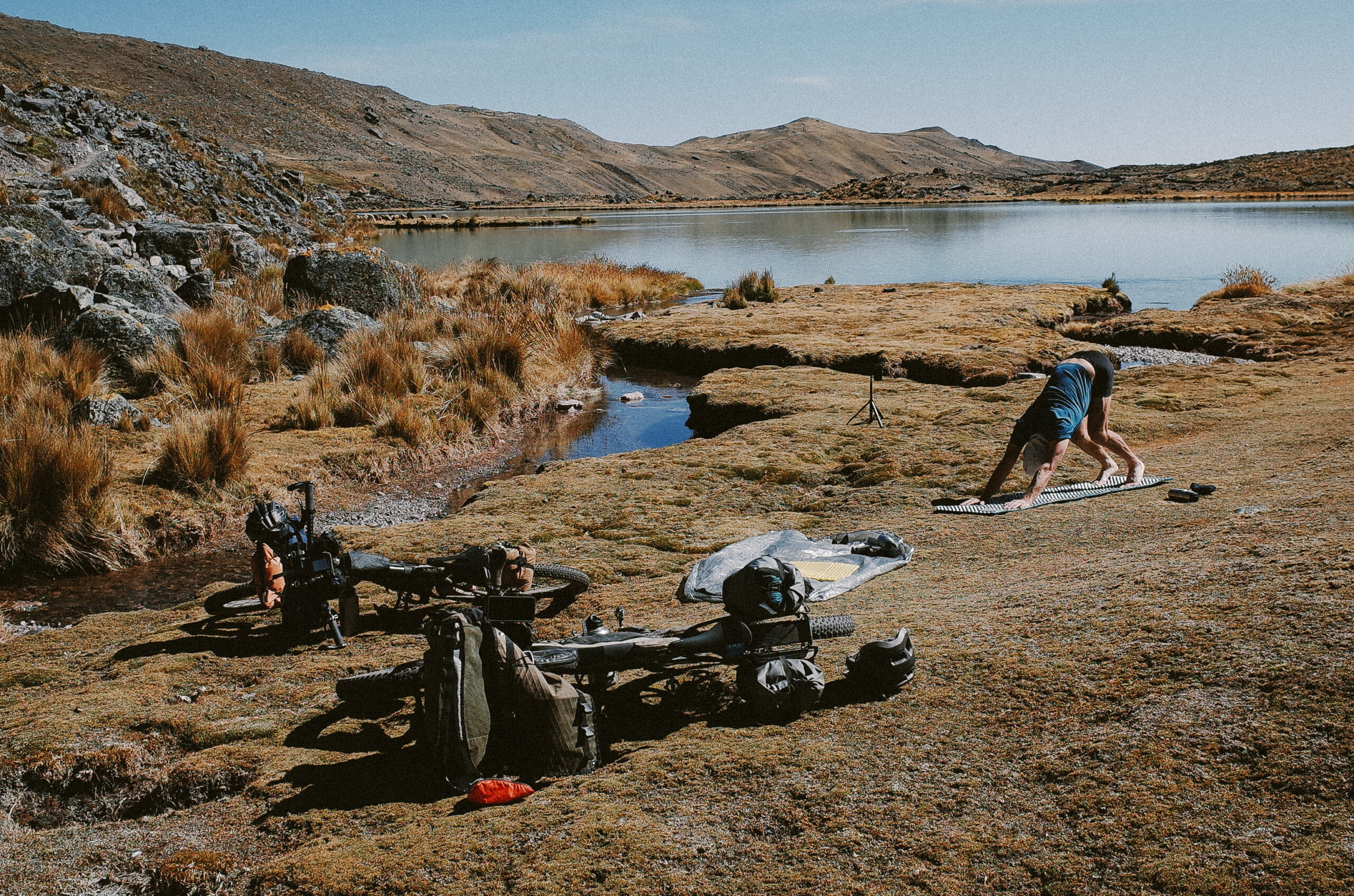
While it’s easy to romanticize bikepacking with your partner, it’s essential to understand and prepare for the challenges you will likely face so that you can overcome, experience joy, and integrate bikepacking into your lives together for the long term.
Relationships are complex and unique to the individuals involved. Communication, trust, compatibility, emotional intimacy, conflict resolution, personality, trauma, codependency, and attachment style are just a few factors that influence our relationship dynamics. These factors tend to play out in more extreme ways when we are hungry, angry, lonely, and tired (HALT), stressors that can commonly occur while bikepacking.
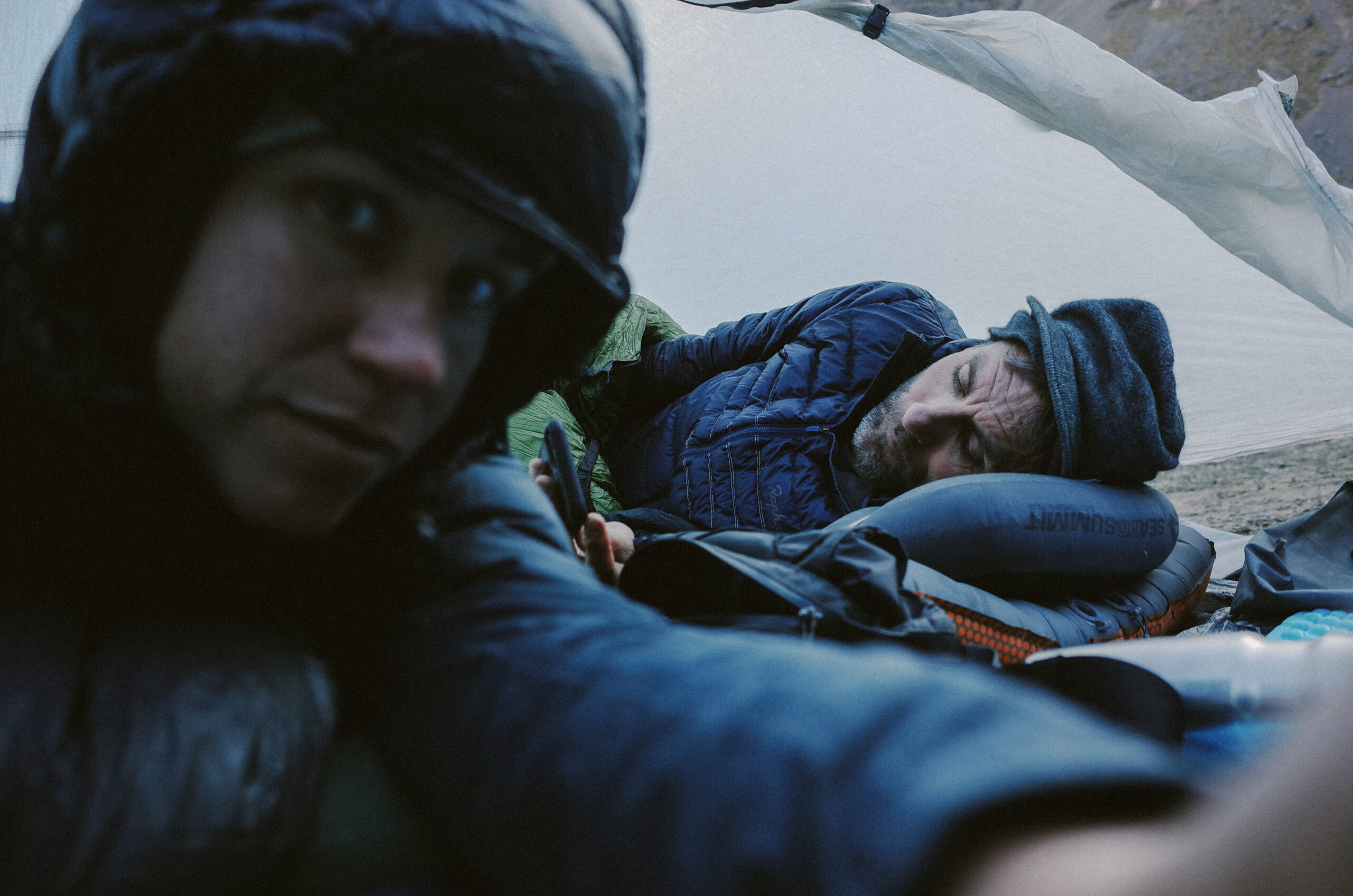
I am an imperfect student on the journey of self-development while in a partnership. I’ve worked with therapists, life coaches, and couples therapists, completed workshops, utilized psychedelic therapies, and read many inspirational texts to support my individual and relational journey. From my experience, relationships require an immense amount of time and trial and error to learn and integrate the skills of self-awareness, communication, empathy, regulation, and conflict repair. A grasp of these skills is essential before setting out on a bikepacking trip with your significant other.
I met my partner, Adam, on the first night of the inaugural grand departure of the Baja Divide in 2017. We instantly connected while sitting next to each other at the pre-ride banquet. The following day, we parted ways, riding the route with our respective groups at different paces. I saw Adam again that spring in southern Arizona during a week-long gravel camp with friends. Finally, while camping in Great Sand Dunes National Park on a bikepacking trip from Durango, Colorado, to Emporia, Kansas, to race Unbound, Adam and I decided to start dating. Since then, we’ve gone on two to five bikepacking trips together yearly and have toured in over fifteen countries.

Not every couple enjoys the privilege of both individuals sharing a love for traveling by bicycle. For some couples, that separation of interests makes their relationship work. Because bikepacking is my passion and an essential part of my career, I value having a partner willing to bikepack with me. Otherwise, I would always be traveling and away from home. I am grateful that Adam is also a skier, runner, and mountaineer. His separate interests allow us to have healthy time apart and space to do things solo or with friends, making enjoying experiences together even sweeter.
If you are single and looking to find someone special to share these bikepacking journeys with, attending gatherings centered around bikes is a great way to meet new people with similar interests. My favorite experience for making deep connections is participating in non-competitive group bikepacking events. You can find a list of such bikepacking events (competitive and non-competitive) on Bikepacking.com/events.
If you are in a relationship with someone who does not currently bikepack but who you would like to go bikepacking with, don’t force it. Instead, consider enticing your partner into bikepacking by suggesting a credit card tour, where you ride from hotel to hotel instead of camping in a place they have always wanted to visit. Europe is great for this sort of trip. If you have the budget, consider booking a supported bikepacking trip with Adventure Cycling or Pannier. A sub-24-hour overnighter (S24O) in a place you both are familiar with is also a great option. The goal is to make it easy and low-consequence so your partner can enjoy the experience and build from there. The process of choosing and planning the trip should also be collaborative.
After going on countless bikepacking trips with my partners over the past ten years, trips all around the world ranging in lengths from 24 hours to up to 3 months at a time, I feel like I have an excellent notion of what challenges relationships can face while touring and some strategies that work to overcome those challenges. To be sure that I covered all the areas of interest for relationships outside of my own, I contacted my online community; I asked them what they would like to know about bikepacking with their significant other. Unsurprisingly, every couple faces some common challenges when bikepacking. The most common are navigating the differential pace, managing conflict and resolution, defining roles and camp tasks, being intimate when camping, and maintaining hygiene.
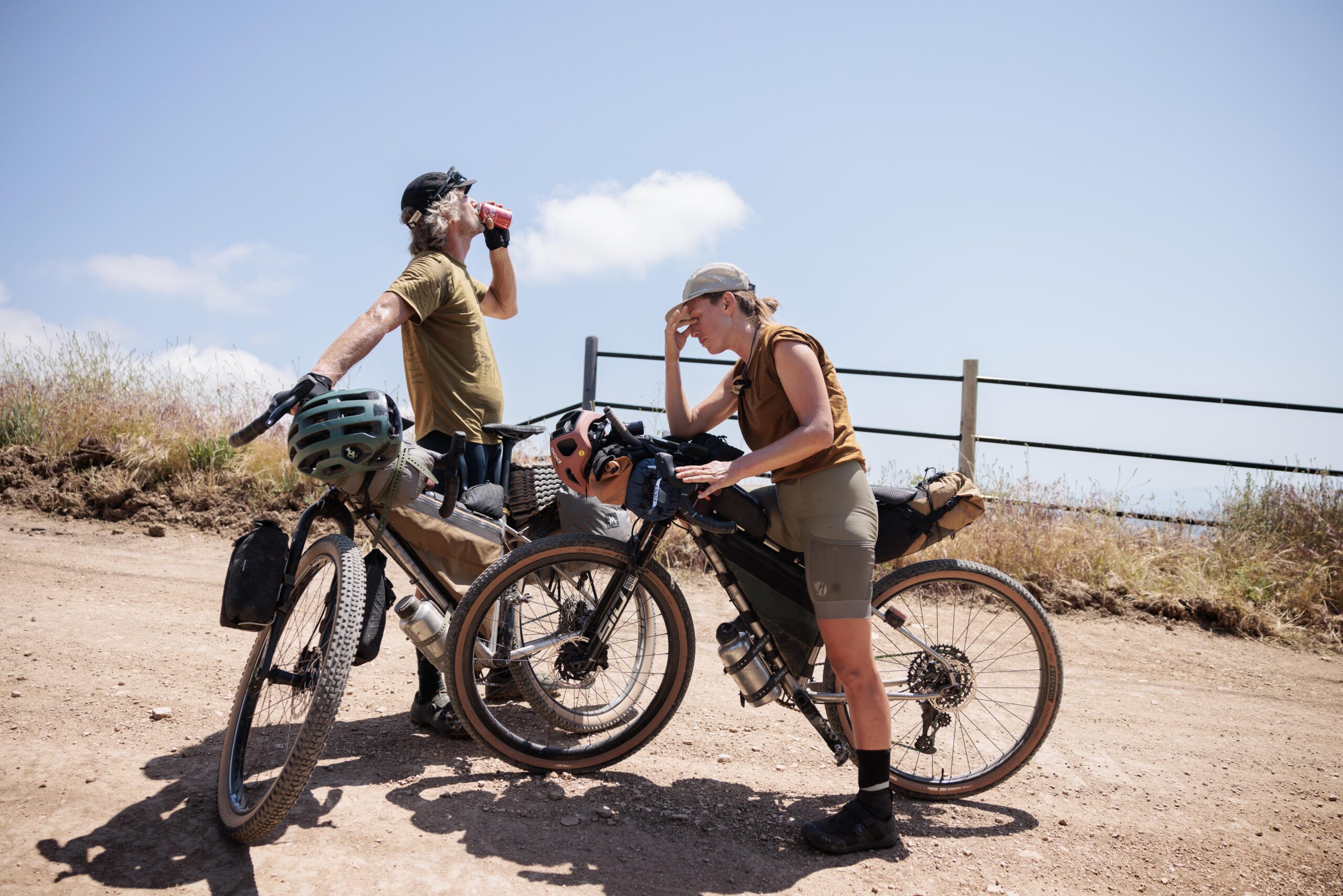
How to Manage the Differential in Pace between Two Partners While Bikepacking
Navigating the differential in pace is the most common challenge among couples. Experience, speed, technical ability, and desire may differ significantly between two people in a relationship trying to bikepack together. Without adequately addressing and compensating for these differences, the person with less experience, slower speed, less technical ability, or desire for type-two fun can quickly feel overwhelmed, stressed, and self-critical in the effort to keep up with their partner. The person with more experience, speed, technical ability, or desire can conversely feel bored, impatient, or anxious over whether their partner is having a good time and will agree to bikepack again. In my relationship, Adam is much stronger than me in the speed and technical department.
Quicker Rider: Carry More Gear
Adam and I address our speed differential by packing Adam’s bike with more gear. For instance, he typically carries the tent, the heaviest food items, and the cooking gear. Loading the faster person’s bike with more weight creates more of a challenge and slows them down. It also takes the load off of the slower person and allows them a less encumbered ride.
Quicker Rider: Find a Hobby
For those partners who are quicker, consider finding a hobby to healthily occupy your time and interest, especially if you are waiting a lot or not feeling challenged. Photography and film are excellent hobbies to combine with bikepacking. You can capture memories of your trip and review the “day’s catch” each night at camp to keep the motivation high. Everyone loves it when a rider is in the shot, so be sure to capture the content of your partner so they can see themselves doing something outside their comfort zone in an epic place. Photography and film encourage frequent regrouping and check-ins rather than extended periods of separation which can feel isolating and confusing.
Slower Rider: Train
In most cases, no amount of training and fitness will close the pace differential between two people. Still, training in preparation for a trip will significantly increase your enjoyment, comfort, and confidence on the ride. Consider riding your bike for at least one hour a day, 4-6 days a week in the weeks leading up to the trip to help your body adapt to riding your bike daily. To build endurance, do a few challenging rides on similar terrain to the route you will follow leading up to the trip. Building core and strength training will also support your comfort on the bike.
Slower Rider: Be Self-Sufficient
If you are the slower rider in the relationship, it’s helpful to go into the trip with the expectation that you will likely be riding alone for periods; that way, you can pack your bike with everything you need to feel confident riding alone. Ideally, each person has a navigation device with the route and carries a repair kit, pump, snacks, water filter, sleep system, and clothing. When each person takes these essential items, anxiety reduces around navigation and separation. Being self-sufficient also adjusts the ride dynamic from dependence on one another to independence, creating more space to enjoy the time one gets to ride solo.
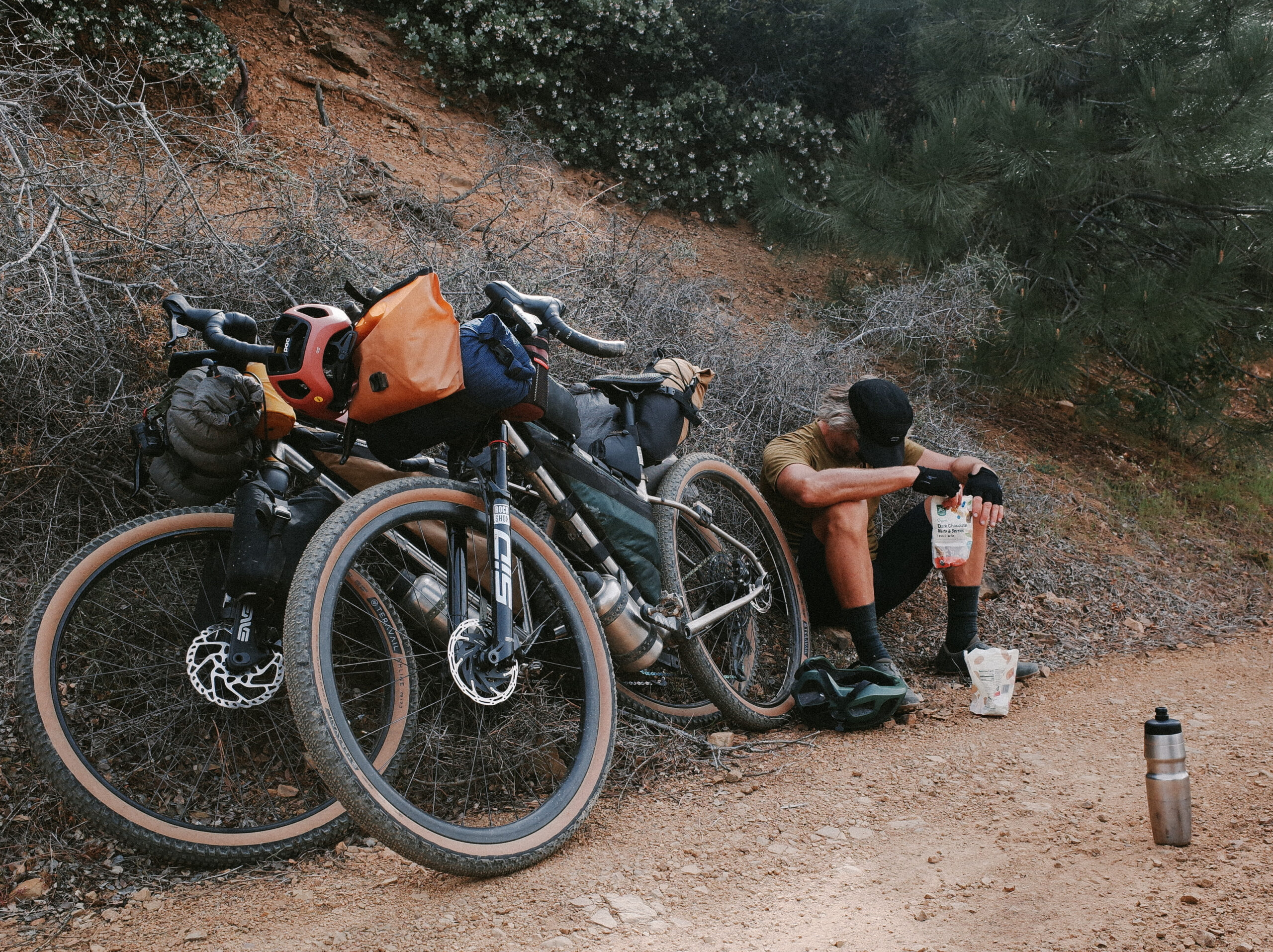
How to Handle Conflict and Resolution on a Bikepacking Trip
Conflicts during a bikepacking trip with your partner are inevitable. Still, they also have the potential to be amplified significantly compared to conflicts at home in day-to-day life. Disagreements on trips can feel more extreme because both people can be physically exhausted, overstimulated, stressed, anxious, hungry, homesick, and emotionally disconnected. Both parties are worn down and not operating with the same capacity they have when sleeping in a warm bed each night, eating three solid meals per day, not riding 8 hours per day, or being exposed to the elements. Mine and Adam’s strategy for managing conflict is to practice preventative maintenance, taking space from each other, and having perspective and compassion for ourselves.
Do Preventative Maintenance
Adam and I practice preventative maintenance on bike tours by carving out time each morning to stretch, journal, and check in with one another about where we are emotionally as individuals, our needs, and our intentions for the day. Sometimes, we only have time to practice some of these things. If so, we’ll do as much as possible or fit the rest throughout the day. When I travel in such proximity to one person, it can be easy for me to lose touch with how I am feeling emotionally. I care for this by journaling or expressing my need to ride alone or listen to music, audiobooks, or podcasts.
Sharing gratitude with and for your partner frequently throughout a trip is another excellent preventative maintenance strategy. Another helpful approach is learning to read the signs of HALT (hungry, angry, lonely, tired). Keeping an eye out for these signs will support you and your partner address your needs before a small, tense exchange grows into something bigger.
Take Space, But Not Too Much Space
When the inevitable happens and a conflict occurs, take space from one another to regulate your nervous system rather than try to reconcile immediately. Mental health professionals typically recommend separating for 20 minutes before attempting to reconcile and reconnect. From personal experience, 20 minutes is an excellent goal with an hour cap. When conflict occurs, consider going for separate walks rather than riding separately. If you continue to ride, avoid getting too separated and stay within eyesight of each other (see Bikepacking for Couples Part I for what could happen if you get too separated). Even if both individuals are self-sufficient, you will still rely on each other to make decisions. For example, suppose a navigational challenge arises, or the weather becomes dangerous. In those moments, you must do your best to put down your differences to decide on the best course of action.
If you are in a location like an airport, where a lot of people are around, and it doesn’t feel comfortable to attempt reconciliation verbally, consider texting or writing notes to each other.
If a conflict is so bad and you and your partner are struggling to reconcile, consider pausing the tour altogether, getting separate rooms for time and space to nurture yourselves, and contacting your support systems for help.
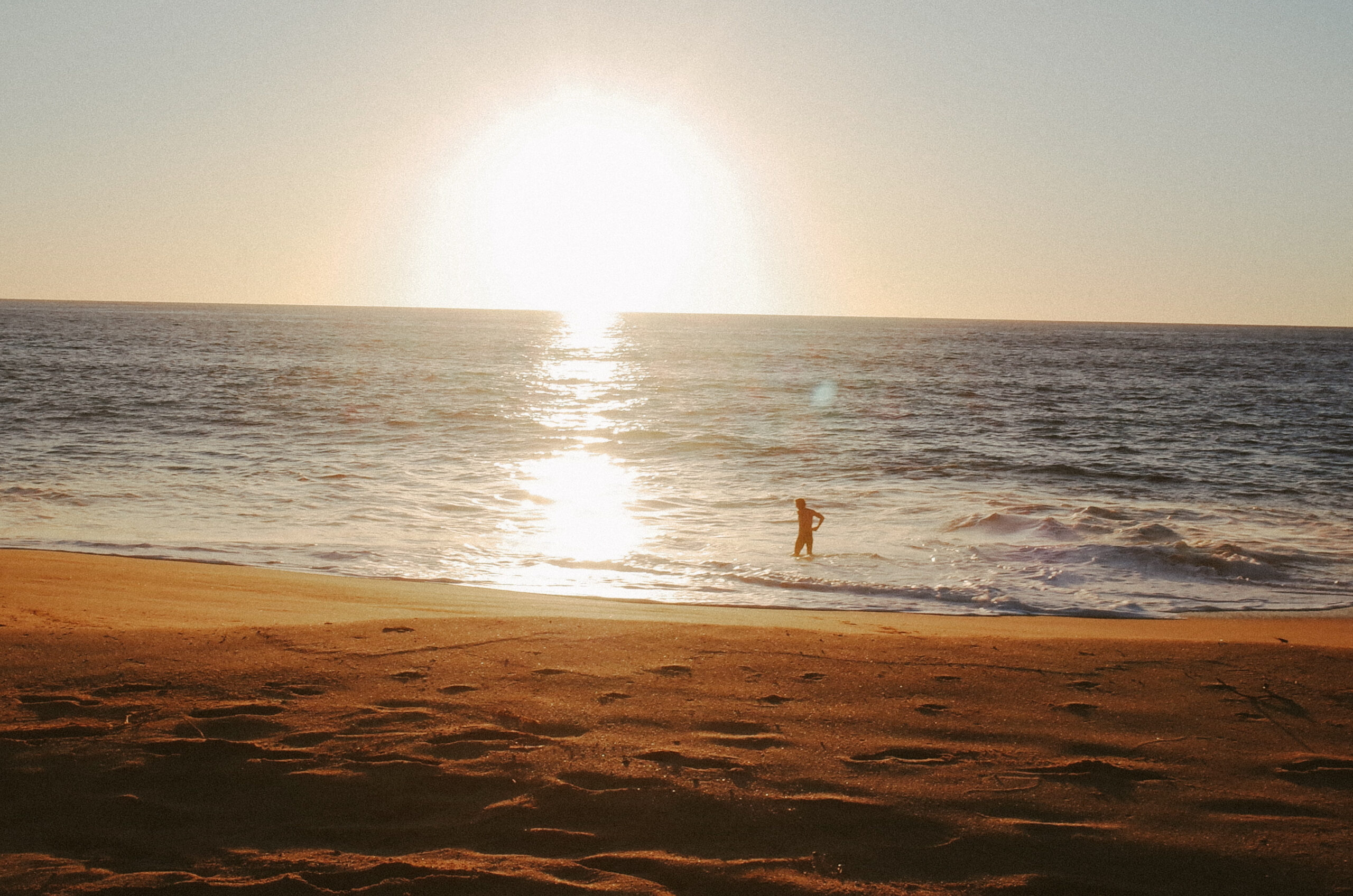
Properly Apologize and Utilize Non-Violent Communication.
A proper apology requires self-reflection, responsibility for your actions, genuine remorse, commitment to growth, empathy, active listening, and openness to feedback. Defensiveness will only prolong the pain. Also, consider utilizing non-violent communication or even taking a course before a big trip. Non-violent communication includes:
- What you see (observation): Start by saying what is happening without blaming or judging. Be straight-up and describe the situation. For example: “When I see or hear ___”
- Why you feel that way (emotion): Share your emotions honestly, whether happy, mad, sad, confused, worried, peaceful, etc. No need to sugarcoat it. For example: “I feel ___”
- Why you feel that way (needs, values, desires, hopes, dreams): Figure out what’s bothering you. It is usually because an important need or value is not being met. For example: “My need or value is ___”
- What you want (request): Finally, ask what you want to happen next. Be clear about what you need or how you want the situation to change. For example: “Would you be willing to ___?”
Have Perspective and Compassion
Remember to put what you are both going through into context and have compassion for yourselves and each other for not showing up as your best selves. You are both operating outside your comfort zone; you may be tired, hungry, exposed to the elements, etc. You are both doing the best you can, considering the circumstances.
Adapting
Sometimes, the trip goes differently than planned; it may be more challenging than expected, understimulating, or one or both individuals are simply not feeling it. Rather than push through for the sake of route completion, consider shaking up the plan by taking a bus or train to jump ahead on the route or switch routes. Or, forgo bikepacking altogether and turn it into a cultural tour or beach vacation. Improvising can be fun and exciting and bring a trip back to life.
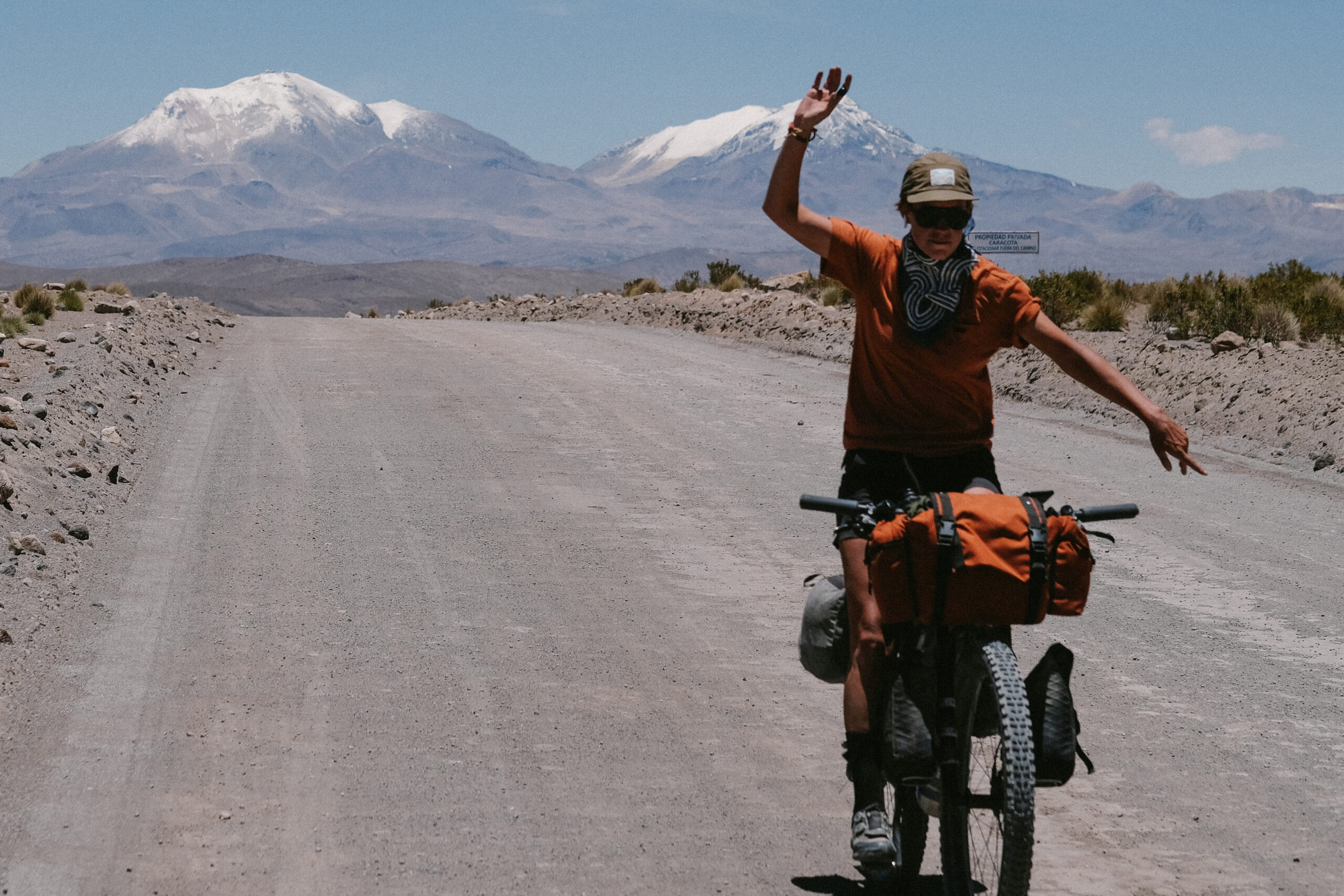
Dividing the Work
Bikepacking as a couple should be a collaborative effort from the planning stage through the end of the trip. In my relationship, I struggle with committing so far in advance, so I let Adam spark the inspiration for the trip location, time of year, and to make any necessary bookings. As we get closer to the trip, I step in to choose and research the route and write up a rough itinerary. Regarding camping, one of us is responsible for setting up the tent while the other person prepares dinner.
Being Intimate When Camping and Hygiene is a Challenge
Good hygiene is something to prioritize if you and your partner wish to maintain intimacy while on a bikepacking trip. If you are traveling in a place with rivers, creeks, or lakes, take a dip or rinse daily. If there is minimal groundwater, bring plenty of baby wipes. A proper baby wipe bath should be done in this order: face, ears, neck, chest, pits, belly, back, privates, and crack. Use a second wipe for your hands, other areas needing extra attention, and your legs and feet. Bring some biodegradable soap, floss, a small container of natural deodorant, tea tree oil (for saddle sores), and natural diaper rash cream (for chafing). Using these items regularly is not only good maintenance for your body while on tour but will also keep odors at bay. Wearing clothing made of natural fibers such as merino wool or linen are antimicrobial and do not absorb smells as badly or as quickly as synthetics. No one enjoys riding behind someone, let alone sleeping beside someone who has been sweating in the same synthetic jersey or cotton t-shirt for the last three days or more. Rinse and wash your clothes frequently.
Conclusion
In essence, bikepacking with your partner can be a transformative and enriching experience, provided that you approach it with open communication, adaptability, and a willingness to navigate the challenges together. With the right mindset and strategies, these adventures can become cherished memories that strengthen your relationship for years to come.
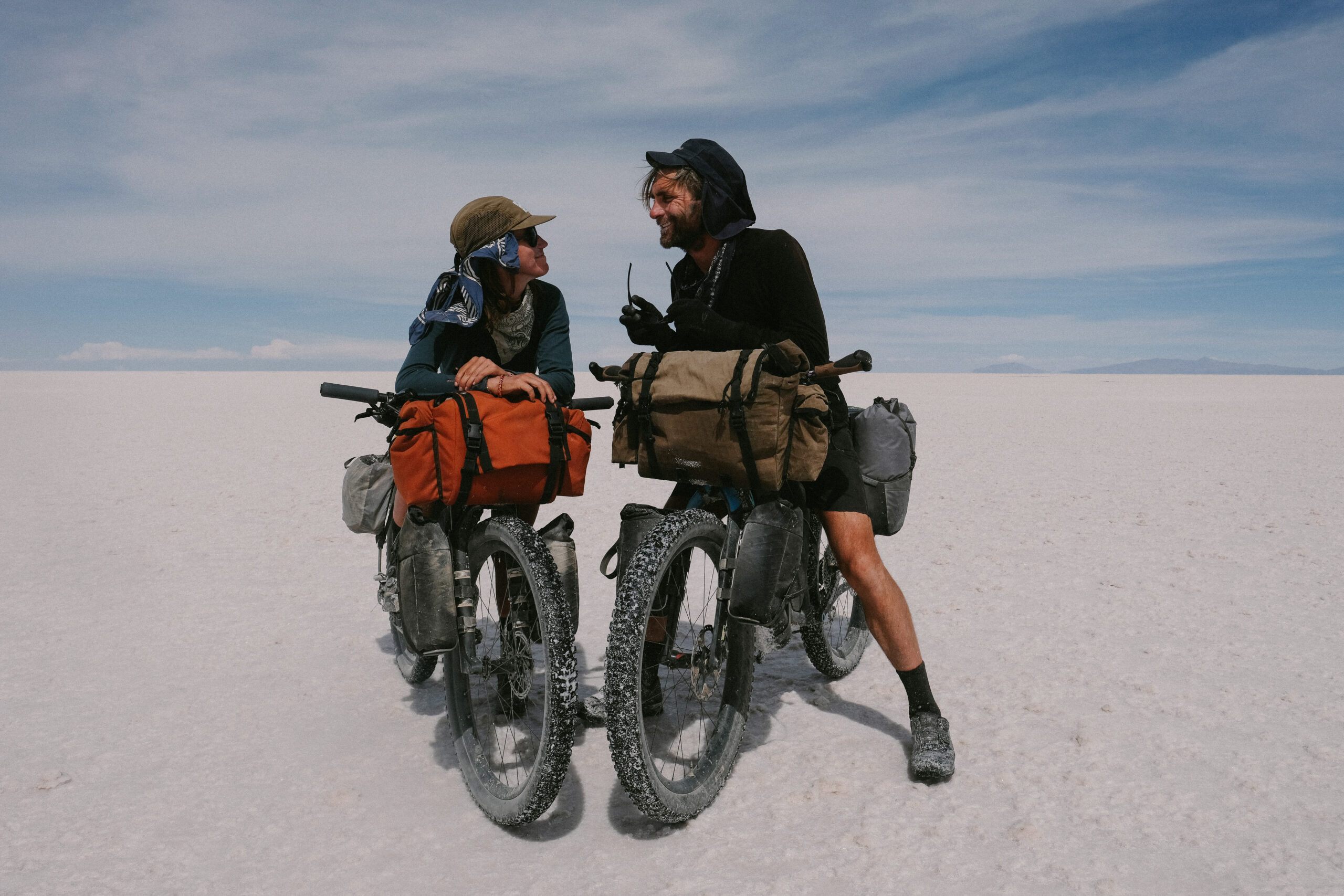
Read Bikepacking For Couples Part I: Lost On The Bolivian Salt Flats, A Story




